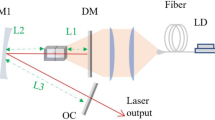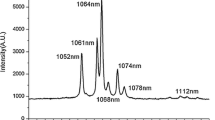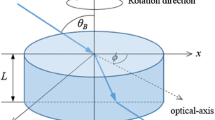Abstract
A simple and compact dual-wavelength continuous wave (CW) laser-diode end-pumped laser operating simultaneously at 1,064.5 and 1,085.5 nm in a single a-cut Nd:YVO4 has been demonstrated. We have used two Nd:YVO4 crystals with different Nd+3 concentrations and lengths; 0.1 %-14 mm and 0.25 %-12 mm. The maximum total output power of 5 and 6.18 W, including 1,064.5 and 1,085.5 nm, is achieved at the incident pump power of 22 and 18 W, with a slope efficiency 23.3 and 32.9 %, respectively, for the crystals of 0.1 %-14 mm and 0.25 %-12 mm. The calculations show both wavelengths lasing at 1,064.5 and 1,085.5 nm can possess the same threshold when reflectivity of the output coupler at 1,064.5 nm is less than 87.5 % and, at this condition, the reflectivity of the output coupler at 1,085.5 nm increases nearly linearly with that of 1,064.5 nm.
Similar content being viewed by others
Avoid common mistakes on your manuscript.
1 Introduction
Simple, compact, and efficient simultaneous dual-wavelength lasers are attractive for a wide range of different scientific and technical applications such as biomedicine, lidar, differential analysis, nonlinear frequency conversion, and especially THz frequency generation [1–5]. The major approach of dual- or multi-wavelength operation is based on balancing the gain and loss at the wavelength by utilizing a dispersion element, such as a prism [6, 7], a diffraction grating [8, 9], precise coating [10, 11], or etalon [12, 13] inside the cavity.
By the time now, continuous-wave multi-wavelength laser for different transitions of Nd3+ have been reported for some crystals such as Nd:YAG, Nd:YLF, Nd:YVO4, (Er, Nd):YAG, (Ho, Nd):YAG, Nd:GdVO4, Nd:LYSO, Nd:YAP, Nd:YAB, Nd:Mgo:LiNbO3, Nd:GSAG, Nd:LuVO4 and Nd:YAIO3 (see for example; [10–25]). Among this family, Nd:YVO4 is commonly used as gain medium in commercial laser products with high efficiency and good beam quality mainly because of the favorable features such as a broad absorption band with higher absorption coefficient, higher stimulated emission cross-section, higher allowable doping level and good thermal and mechanical properties. In most cases, an Nd:YVO4 laser operates at one particular wavelength around 0.9, 1.06, and 1.3 μm, corresponding to the transitions of 4F3/2 → 4I11/2, 4F3/2 → 4I13/2, or 4F3/2 → 4I9/2, respectively, with comparatively large stimulated emission cross-sections. Each of them splits into closely packed Stark levels, especially transition of 4F3/2 → 4I11/2, which permits multi-wavelength operation from the inter-manifold transitions. We may note that the dual-wavelength operation on only one transition of 4F3/2 → 4I11/2, 4F3/2 → 4I13/2, or 4F3/2 → 4I9/2 has potential for coherent THz radiation generation. Coherent THz waves, the electromagnetic radiation in the 0.1–10 THz, are attractive for THz radar, spectral identification of materials, imaging, and sensing [26–28].
Recently we have reported a tunable single and multiwavelength continuous-wave c-cut Nd:YVO4 laser [13]. As shown in Fig. 1, c-cut Nd:YVO4 has a unique advantage that the cross-section of 1,067 nm is about 1.5–2 times of 1,085.5 and 1,088 nm; which makes it suitable for tunable multiwavelength operation at transitions of 4F3/2 → 4I11/2 in a single crystal [29]. However, poor thermal properties and small saturation fluence of c-cut Nd:YVO4 at room temperature make it unsuitable for high-power operation. An a-cut Nd:YVO4 crystal has advantages of four times higher emission cross-section and better thermal and mechanical properties than that of c-cut crystal.
Stimulated emission cross-section for the 4F3/2 → 4I11/2 transition of Nd:YVO4 [29]
Some of the multiwavelength lasers reported over the past years on transitions of 4F3/2 → 4I11/2 are listed in Table 1. It is evident that most of the multiwavelength Nd:YVO4 lasers are limited to emission around the main oscillation of 1,064 nm. It is because, the much higher emission cross-section at 1,064 nm in an a-cut Nd:YVO4 crystal suppresses the oscillation of the other transitions and makes it difficult to perform multiwavelength emission on other transitions. In this paper, we report, for the first time to the best of our knowledge, simultaneous dual-wavelength operation at 1,064.5 and 1,085.5 nm, originate from 4F3/2 level and terminating at the 4I11/2 level, by proper cavity design in a single a-cut Nd:YVO4. We have utilized two Nd:YVO4 crystals with different Nd+3 concentration and length; 0.1 %-14 mm and 0.25 %-12 mm. The maximum total output power 5 and 6.18 W was achieved at the incident pump power 22 and 18 W, corresponding to the total optical-to-optical efficiency 22.7 and 34.3 %, respectively, for the crystals of 0.1 %-14 mm and 0.25 %-12 mm.
2 Experimental setup
The experimental arrangement is schematically shown in Fig. 2. The laser crystal is an a-cut, 0.25 (or 0.1) at % Nd3+ doped Nd:YVO4 crystal with a length of 12 mm (or 14 mm) and an aperture of 3 × 3 mm2. The pump source is a fiber-coupled laser diode at 808 nm with a core diameter of 800 μm and a numerical aperture of 0.22. The pump radiation was coupled into the laser crystal by an optical focusing system with a 35-mm focal length and 97.6 % transfer efficiency. The input concave mirror M 1, having a radius of curvature of 250 mm, was coated with anti-reflection (AR) dielectric layers at 808 nm (T > 99.5 %) and high-reflection (HR) dielectric layers between 1,000 and 1,200 nm (R > 99.9). The M 2 mirror is a flat mirror with reflectance of 99.4 and 90.76 % at 1,086 and 1,064 nm, respectively. The pumping side (S 1) of the laser crystal has high-transmission coating at 808 nm (T > 99.5 %) and both sides were AR-coated at 1,064 and 1,086 nm (R < 0.5 %). The laser crystal was wrapped in an indium foil with 0.2 mm thickness and was placed in a copper holder cooled to 20 °C favorable for maintaining the thermal stability of the laser. The geometry length of the cavity was 75 mm.
3 Results and discussion
The alignment for the laser cavity and the pump beam was carefully adjusted to obtain a higher laser output in the CW regime with TEM00 mode. The emission spectrum of the laser is shown in Fig. 3 at an incident pump power of 10 W. It is clearly seen that only 1,064.5 and 1,085.5 nm emissions were detected in the range 1,060–1,090 nm. Figure 4 shows the average output spectrum at 1,064.5 and 1,085.5 nm with the spectral bandwidth (FWHM) of ~0.08 nm, which was measured over 50 pulses.
We also measured the output power as a function of the incident pump power for different gain mediums with properties of 0.1 %-14 mm and 0.25 %-12 mm. Fig. 5 shows the measured total output power at dual-wavelength versus pump power. It can be seen from Fig. 5, the output power increases linearly with the pump power at first, and then decreases because of thermal effects. In order to reduce the influence of thermal effects, the length of the cavity should be reduced as possible. We can also see that the thermal effects in the laser crystal of 0.1 %-14 mm (longer crystal with lower doping level) are weaker than that of 0.25 %-12 mm, which are in good agreement with the theoretical results pointed out in [30]. By increasing the pump power and analyzing the emission spectrum of the laser, the threshold oscillation of 1,064.5 and 1,085.5 nm was obtained at about 0.67 and 1.15 W, respectively, for the crystal with 0.25 % Nd+3 concentration and 12 mm length. The maximum output power of 5 and 6.18 W is achieved at the incident pump power of 22 and 18 W, corresponding to the optical conversion efficiency of 22.7 and 34.4 %, and the slope efficiency of 23.3 and 32.9 %, respectively, for the crystals of 0.1 %-14 mm and 0.25 %-12 mm. It should be pointed out that in the present configuration the gain competition between ~1,073 nm and other transitions suppresses the oscillation of 1,073 nm.
In order to explain the oscillation 1,085.5 nm, it is best to begin with some theory regarding dual-wavelength lasing for a single ion system operating on the 4F3/2 → 4I11/2 transition. This transition operates as a four-level laser. For a four-level laser, the single-pass gain can be written as [30]:
where τ f is the lifetime of the upper laser level, σ e is the emission cross-section, P in is the incident pump power, and η p,i = η t η a(ν i /ν p ) is the pumping efficiency, where η t is the optical transfer efficiency, and η a is the absorption efficiency, ν i is the laser photon frequency, ν p is the pump photon frequency, and V eff is the mode volume efficiency between the pump and the laser modes as given by:
where s i is the normalized cavity mode intensity distribution and r p is the normalized pump intensity distribution in the active medium. The subscripts 1 and 2 denote the gain at λ 1 = 1,064.5 nm and λ 2 = 1,085.5 nm, respectively. The 1,064.5 and 1,085.5 nm lines of Nd:YVO4 crystal are both from the transition 4F3/2 → 4I11/2 but corresponding to different Stark energy levels. Accurately, the 1,064.5 nm radiation comes from R2 → Y2 transition and 1,085.5 nm radiation from R1 → Y5, as shown in Fig. 6.
The laser energy levels and transitions from 4F3/2 to 4I11/2 of Nd:YVO4 [32]
Assuming a Gaussian mode with negligible diffraction in the gain medium for cavity and pump modes, by eliminating V eff, Eq. (1) can be rewritten as [31]:
where w l0,i and w p are beam radii for laser and pump modes at the waist in the active medium, respectively, and l is the gain medium length. Since the two lasing wavelengths oscillate in the same cavity and have the same upper level, therefore, Eq. (3) can be expressed as:
where η q = v/v p is the quantum efficiency. For a given gain g i and total cavity round-trip loss δ i = L i − ln(R i ), the threshold condition of oscillation is given by:
or
where R i is the reflectivity of the output coupler at λ i and L i is the round-trip cavity internal loss. For the a-cut Nd:YVO4, σ e,1 = 13.4 × 10−19 cm2, σ e,2 = 1.74 × 10−19 cm2 [29], L i = 0.02 is measured using the Findlay–Clay method [33]. η q,1 = 75.9 % and η q,2 = 74.5 % for pumping at 808 nm.
Taking into consideration the above data, we can obtain:
The measured pump thresholds of 0.67 and 1.15 W for 1,064.5 and 1,085.5 nm, respectively, show a good agreement with the theoretical Eq. (6).
From Eqs. (4) and (5), the condition that both transitions possess the same threshold can be given by:
With Eq. (7) and experiment parameters, the reflectivity of the output coupler at λ 2 is plotted as a function of reflectivity at λ 1. It is obvious from Fig. 7 that both wavelength lasing at 1,064.5 and 1,085.5 nm can possess the same threshold when R 1 is less than 87.5 % and reflectivity at 1,085.5 nm increases nearly linearly with that of 1,064.5 nm.
The corresponding reflectivity at lasing wavelength λ 2 = 1,085.5 nm as a function of reflectivity at λ 1 = 1,064.5 nm according to Eq. (7)
4 Conclusions
In summary, we experimentally demonstrated a compact, simple CW dual-wavelength simultaneous oscillation Nd:YVO4 laser at 1,064.5 and 1,085.5 nm by proper cavity design using crystals with different doping levels and lengths; 0.1 %-14 mm and 0.25 %-12 mm. A total maximum output power of 5 and 6.18 W is achieved at the incident pump power of 22 and 18 W, with slope efficiency of 23.3 and 32.9 %, respectively, for the crystals of 0.1 %-14 mm and 0.25 %-12 mm. Our investigation shows both wavelengths lasing at 1,064.5 and 1,085.5 nm can possess the same threshold when reflectivity of output coupler at 1,064.5 nm is less than 87.5 % and, at this condition, the reflectivity of the output coupler at 1,085.5 nm increases nearly linearly with that of 1,064.5 nm. The difference frequency interactions among these wavelengths may be used to generate radiation at 5.5 THz by using an appropriate nonlinear crystal.
References
P. Hering, J.P. Lay, S. Stry (eds.), Laser in environmental and life sciences: modern analytical method (Springer, Heidelberg, Berlin, 2003)
S.N. Son, J.J. Song, J.U. Kang, C.S. Kim, Simultaneous second harmonic generation of multiple wavelength laser outputs for medical sensing. Sensors (Basel) 11(6), 6125–6130 (2011)
R.W. Farley, P.D. Dao, Development of an intracavity-summed multiple-wavelength Nd:YAG laser for a rugged, solid-state sodium lidar system. Appl. Opt. 34, 4269–4273 (1995)
A. Saha, A. Ray, S. Mukhopadhyay, N. Sinha, P.K. Datta, Simultaneous multi-wavelength oscillation of Nd laser around 1.3 μm: a potential source for coherent terahertz generation. Opt. Express 29, 4721–4726 (2006)
E. Herault, F. Balembois, P. Georges, 491 nm generation by sum-frequency mixing of diode pumped neodymium lasers. Opt. Express 13, 5653–5661 (2005)
C.W. Luo, Y.Q. Yang, I.T. Mak, Y.H. Chang, K.H. Wu, T. Kobayashi, A widely tunable dual-wavelength CW Ti: sapphire laser with collinear output. Opt. Express 16, 3305–3309 (2008)
W. Li, Q. Hao, J. Ding, H. Zeng, Continuous-wave multi-wavelength diode-pumped Yb:GYSO laser. J Opt A Pure Appl Opt 10, 095307 (2008)
F. Wang, D.Y. Shen, D.Y. Fan, Q.S. Lu, Widely tunable dual-wavelength operation of a high-power Tm: fiber laser using volume Bragg gratings. Opt. Lett. 35, 2388–2390 (2010)
M. Hemmer, Y. Joly, L. Glebov, M. Bass, M. Richardson, Volume Bragg Grating assisted broadband tunability and spectral narrowing of Ti: sapphire oscillators. Opt. Express 17, 8212–8219 (2009)
H.Y. Shen, R.R. Zeng, Y.P. Zhou, G.F. Yu, C.H. Huang, Z.D. Zeng, W.J. Zhang, Q.J. Ye, Simultaneous multiple wavelength laser action in various neodymium host crystals. IEEE J. Quantum Electron. 27, 2315–2319 (1991)
S. Zhuang, D. Li, X. Xu, Z. Wang, H. Yu, J. Xu, L. Chen, Y. Zhao, L. Guo, X. Xu, Continuous-wave and actively Q-switched Nd:LSO crystal lasers. Appl. Phys. B (2012) 107, 41–45 (2011)
C.Y. Li, Y. Bo, J.L. Xu, C.Y. Tian, Q.J. Peng, D.F. Cui, Z.Y. Xu, Simultaneous dual-wavelength oscillation at 1116 and 1123 nm of Nd:YAG laser. Opt. Commun. 284, 4574–4576 (2011)
G. Shayeganrad, Y.-C. Huang, L. Mashhadi, Tunable single and multiwavelength continuous-wave c-cutNd:YVO4 laser. Appl. Phys. B (2012). doi:10.1007/s00340-012-4958-0
B.Z. Li, C.G. Sun, A.F. Zang, X.H. Zhang, M. Zhao, X.Y. Chen, J.B. Wang, G.B. Chen, Simultaneous dual-wavelength CW laser operation at 1064 and 930 nm in Nd3+:YAlO3. Laser Phys. 21, 891–893 (2011)
B.M. Walsh, Dual wavelength lasers. Laser Phys. 20, 622–634 (2010)
M.L. Rico, J.L. Valdés, J. Martínez-Pastor, J. Capmany, Continuous-wave dual-wavelength operation at 1062 and 1338 nm in Nd3+:YAl3(BO3)4 and observation of yellow laser light generation at 592 nm by their self-sum-frequency-mixing. Opt. Commun. 282, 1619–1621 (2009)
M.B. Danailov, I.Y. Milev, Simultaneous multiwavelength operation of Nd:YAG laser. Appl. Phys. Lett. 61, 746–749 (1992)
A.J. Singh, S.K. Sharma, P.K. Mukhopadhyay, S.M. Oak, Dual wavelength operation in diode-end-pumped hybrid vanadate laser. Pramana J. Phys. 75, 929 (2010)
S. Zhuang, D. Li, X. Xu, Z. Wang, H. Yu, J. Xu, L. Chen, Y. Zhao, L. Guo, X. Xu, Continuous-wave and actively Q-switched Nd:LSO crystal lasers. Appl. Phys. B 107, 41 (2012)
B. Wu, P. Jiang, D. Yang, T. Chen, J. Kong, Y. Shen, Compact dual-wavelength Nd:GdVO4 laser working at 1063 and 1065 nm. Opt. Express 17, 6004–6009 (2009)
L. Chen, X. Xu, Z. Wang, D. Li, H. Yu, J. Xu, S. Zhuang, L. Guo, Y. Zhao, X. Xu, Efficient dual-wavelength operation of Nd:LYSO laser by diode pumping aimed toward the absorption peak. Chinese Opt. Lett. 9, 071403 (2011)
I.V. Ievlev, I.V. Koryukin, Y.S. Lebedeva, P.A. Khandokhin, Continuous two-wave lasing in microchip Nd:YAG lasers. Quantum Electron. 41, 715–721 (2011)
Y.P. Huang, C.Y. Cho, Y.J. Huang, Y.F. Chen, Orthogonally polarized dual-wavelength Nd:LuVO4 laser at 1086 nm and 1089 nm. Opt. Express 20, 5644–5651 (2012)
L. Chen, Z. Wang, S. Zhuang, H. Yu, Y. Zhao, L. Guo, X. Xu, Dual-wavelength Nd:YAG crystal laser at 1074 and 1112 nm. Opt. Lett. 36, 2554–2556 (2011)
H. Yoshioka, S. Nakamura, T. Ogawa, S. Wada, Dual-wavelength mode-locked Yb:YAG ceramic laser in single cavity. Opt. Express 18, 1479–1486 (2010)
B. Ferguson, X.C. Zhang, Materials for terahertz science and technology. Nat. Mater. 1, 26–33 (2002)
J.F. Federici, B. Schulkin, F. Huang, D. Gary, R. Barat, F. Oliveira, D. Zimdars, THz imaging and sensing for security applications—explosives, weapons and drugs. Semicond. Sci. Technol. 20(7), S266–S280 (2005)
J.B. Baxter, G.W. Guglietta, Terahertz spectroscopy. Anal. Chem. 83(12), 4342–4368 (2011)
Y. Sato, T. Taira, Spectroscopic properties of neodymium-doped yttrium orthovanadate single crystals with high-resolution measurement. Jpn. J. Appl. Phys. 41, 5999–6002 (2002)
G. Shayeganrad, Efficient design considerations for end-pumped solid-state-lasers, Optics and laser Technology. Opt. Laser Technol. 44, 987–994 (2012)
G. Shayeganrad, Optimum Design of End-Pumped Solid-State Lasers, ed. A. Al-Khursan. Solid State Laser (InTech, 2012) doi:10.5772/38902
D.K. Sardar, R.M. Yow, Stark components of 4F3/2, 4I9/2 and 4I11/2 manifold energy levels and effects of temperature on the laser transition of Nd3+ In YVO4. Opt. Mater. 14, 5–11 (2000)
D. Findly, R.A. Clay, The measurement of internal losses in 4-level lasers. Phys. Lett. 20, 277 (1966)
Author information
Authors and Affiliations
Corresponding author
Rights and permissions
About this article
Cite this article
Shayeganrad, G., Mashhadi, L. Dual-wavelength CW diode-end-pumped a-cut Nd:YVO4 laser at 1064.5 and 1085.5 nm. Appl. Phys. B 111, 189–194 (2013). https://doi.org/10.1007/s00340-012-5299-8
Received:
Accepted:
Published:
Issue Date:
DOI: https://doi.org/10.1007/s00340-012-5299-8











